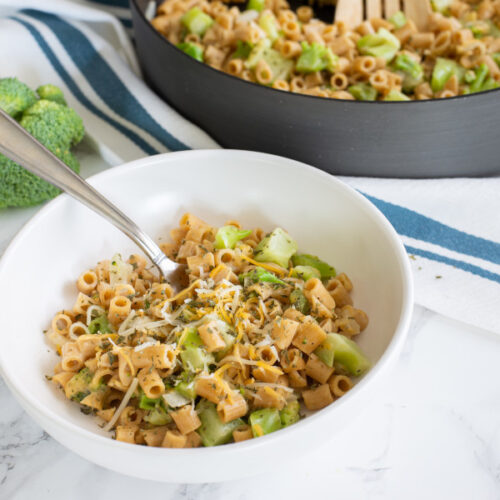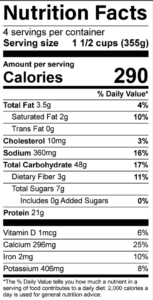

Skillet Mac And Cheese
Ingredients
- 1/2 cup onion - chopped
- 2 cups frozen broccoli - defrosted
- 1 cup fat free milk
- 1/4 tsp black pepper
- 1 1/4 cups reduced fat cheddar cheese - shredded
- 4 cups 100% whole wheat pasta - cooked
- non-stick cooking spray
Instructions
- Wash your hands and clean your cooking area.
- Spray a large non-stick skillet evenly with non-stick cooking spray.
- Add onions and broccoli. Cook on medium heat for 2 minutes.
- Add milk, pepper and cheese to the skillet. Cook on medium to low heat until cheese melts. Stir frequently.
- Add pasta and stir to combine all ingredients. Cook until pasta is warm, 2-3 minutes.
- Serve immediately and enjoy!!
Nutrition Facts Servings
 Nutrition Facts Servings: 4, Serv. size: 1 ½ cups, Amount per serving: Calories 290, Total Fat 3.5g (4% DV), Sat. Fat 2g (10% DV), Trans Fat 0g, Cholest. 10mg (3% DV), Sodium 360mg (16% DV), Total Carb. 48g (17% DV), Fiber 3g (11% DV), Total Sugars 7g (Incl. 0g Added Sugars, 0% DV), Protein 21g, Vit. D (6% DV), Calcium (25% DV), Iron (10% DV), Potas. (8% DV).
Nutrition Facts Servings: 4, Serv. size: 1 ½ cups, Amount per serving: Calories 290, Total Fat 3.5g (4% DV), Sat. Fat 2g (10% DV), Trans Fat 0g, Cholest. 10mg (3% DV), Sodium 360mg (16% DV), Total Carb. 48g (17% DV), Fiber 3g (11% DV), Total Sugars 7g (Incl. 0g Added Sugars, 0% DV), Protein 21g, Vit. D (6% DV), Calcium (25% DV), Iron (10% DV), Potas. (8% DV).



